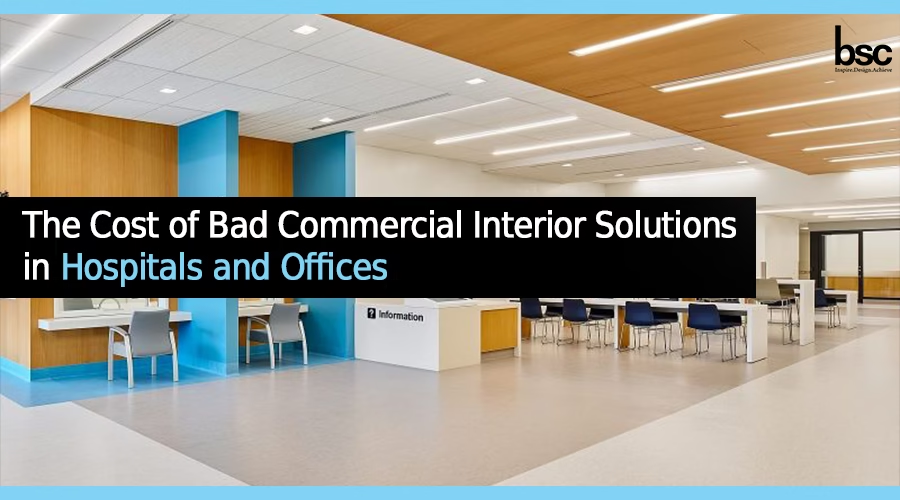Effects of Choosing Poor Commercial Interior Solutions
For every space, functionality and design come at a cost. While aesthetics are a fundamental in most structures, for spaces like hospitals and offices, poor choices of interiors—especially in terms of ceilings, furniture, and sanitary fittings—can eventually lead to dire and quite expensive consequences.
Escalating maintenance bills, compromised hygiene, and depleting productivity are all the result of choosing bad commercial interior materials. While one may fail to acknowledge their importance, the hidden costs can be difficult to cover once invested. For better awareness, let us uncover the many downsides of hospital and office interiors that often get overlooked and lead to substantial losses.
1. Troubles of Maintenance and Cost-Effectiveness
Opting for substandard sanitary ware, cheap ceiling panels, and mediocre furniture might seem pocket-friendly at first, but such choices are a ticking time bomb when it comes to seamless maintenance. When one constructs a hospital, such negligence can cost heavily as these high-traffic space demands interiors that can sustain long, consecutive usage. When sanitary wares aren’t properly installed or maintained and keep malfunctioning, such repeated mishaps require frequent repairs and even lead to structural damage due to excessive water leakage.
In addition to that, ceiling systems that aren’t crafted to resist moisture or fire erode quickly. Tiles dip with mold and discoloration appearing, triggering poor indoor air quality and other health hazards. Similarly, in offices, poorly planned acoustics and sagging tiles often result in disrupted maintenance.
2. Downtime and Operational Disturbances
During renovation and repairs, there are chances of office furniture being displaced or hospitals needing to close off certain sections for smooth maintenance work. However, such scenarios often lead to unavoidable downtime that ends up hindering the productivity of a space. Let’s consider hospitals where such moments mean fewer patient admissions, rescheduling surgeries, or moving critical services, directly affecting revenue and care delivery. For offices, it translates to dull productivity, missed deadlines, and employee dissatisfaction.
For poorly installed ceilings, they often interfere with lighting and HVAC systems, leading to more delays and inefficiencies. In the long run, such interventions caused by recurring fixes turn out to be far more expensive than investing in quality interiors.
3. Compromised Hygiene and Infection Control
The biggest problem that can occur due to bad interiors is the impact on hygiene and infection control in hospitals and offices. Talking about healthcare facilities, such vulnerable areas can be affected with unprecedented infections and diseases by choosing non-sterile ceiling systems, cracked sanitary ware, and furniture with dirt-trapping joints. Here, even ceilings play a crucial role in absorbing moisture and resisting microbial growth in sterile environments like ICUs and operating rooms.
In case of workspaces, while certain issues are not persistent, shared washrooms and common areas still pose health risks. Poor ventilation, dirty furniture, or ruptured sanitary fittings can cause depleting health among employees, affecting overall productivity and morale.
4. Ergonomic and Psychological Toll
Workspaces, on many occasions, impact employees’ mental health. A simple reason for this is poor interiors. Non-ergonomic furniture, unstable desks, or poor lighting contribute to musculoskeletal issues, eye strain, and general discomfort. Over time, this leads to fatigue, reduced performance, and increased medical claims.
For hospitals as well, where the environment caters to the sick and injured, poorly designed interiors are only going to trigger stress among visitors and patients alike. Uncomfortable seating, compact layouts, and bad acoustics can increase anxiety and decrease overall satisfaction.
5. Neglecting Energy and Long-Term Installments
Use of mediocre ceiling systems often means poor thermal insulation and inadequate lighting distribution. For large facilities like offices and hospitals, such issues are rather problematic, as lighting systems and climate control are major energy consumers. Incompetent design or cheap materials can lead to unnecessarily higher consumption and overworked HVAC systems.
Alternatively, investing in energy-efficient ceilings and reflective furniture finishes can significantly contribute to sustainability goals.
Towards a Smarter Route
Compromising well-being to save cost can never be the ideal planning. For high-traffic spaces like offices and healthcare facilities, the investment made to build such structures should be appropriate rather than safe. Selecting reliable commercial interior solutions such as durable sanitary ware, fire-rated and acoustic-friendly ceilings, and ergonomic and easy-to-clean furniture can help minimize certain hidden costs while being environmentally friendly.
With BSC Interiors closely working with clients, we bring in expert interior solutions and suggestions that stand the test of time while guaranteeing high performance. So for your next project, save yourself from the troubles of hidden costs and contact us for expert solutions.
